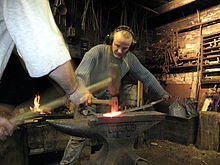
Back Aambeeld Afrikaans Enclusa AN سندان (أداة) Arabic Xunque AST Zindan (alət) Azerbaijani Totopan BCL Наковалня Bulgarian Annev Breton Enclusa Catalan Нуьйжа CE
This article needs additional citations for verification. (January 2010) |



An anvil is a metalworking tool consisting of a large block of metal (usually forged or cast steel), with a flattened top surface, upon which another object is struck (or "worked").
Anvils are massive because the higher their inertia, the more efficiently they cause the energy of striking tools to be transferred to the work piece. In most cases the anvil is used as a forging tool. Before the advent of modern welding technology, it was the primary tool of metal workers.[1]
The great majority of modern anvils are made of cast steel that has been heat treated by either flame or electric induction. Inexpensive anvils have been made of cast iron and low-quality steel, but are considered unsuitable for serious use, as they deform and lack rebound when struck.
The largest single piece tool steel anvil that is heat treated is 1600 pounds. This anvil was made in 2023 by Oak Lawn Blacksmith. There are larger anvils that are made out of multiple pieces such as “The mile long anvil” made by Napier which weighs 6500 pounds. This anvil is not heat treated or made from tool steel.
- ^ Hahn, Robert. Archaeology and the Origins of Philosophy. Publisher: State University of New York Press 2010. ISBN 978-1438431659